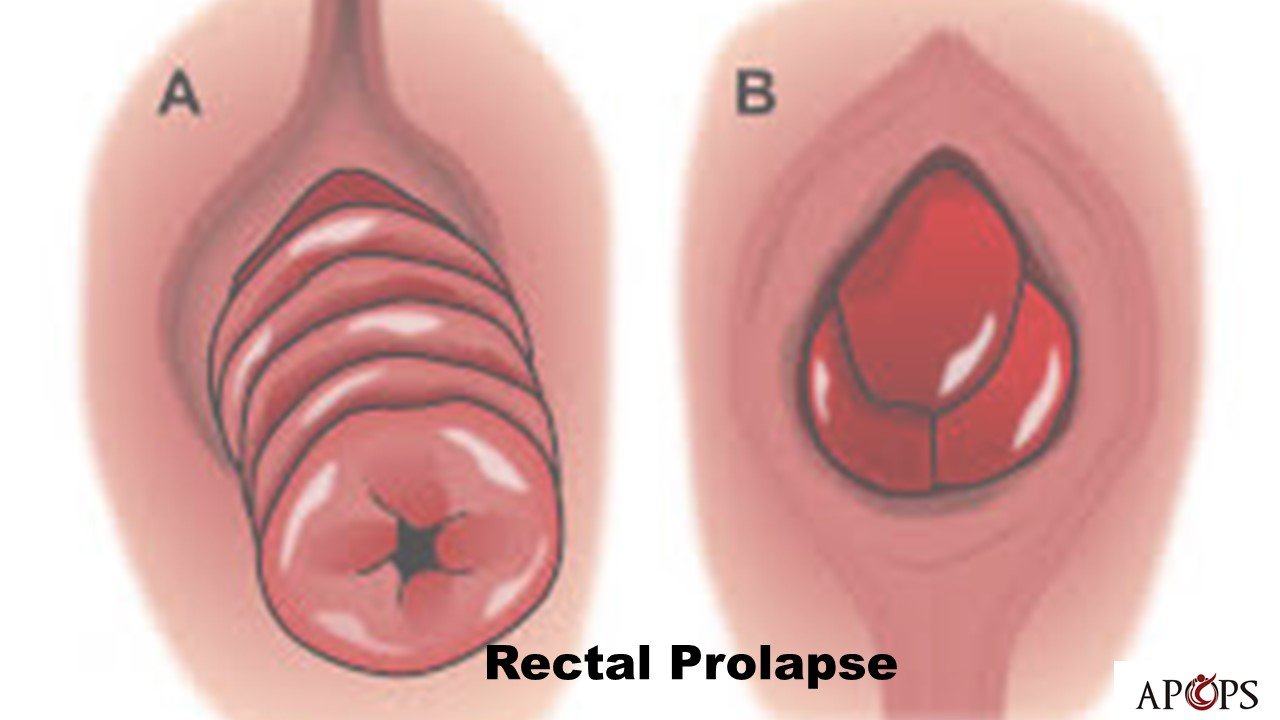Rectocele, rectal prolapse, enterocele, intussusception, what’s the distinction? Women often think rectocele and rectal prolapse are the same thing. They are not. Enterocele is sometimes undiagnosed when other types of POP are recognized. Intussusception is little known outside of those diagnosed with it.Articles about pelvic organ prolapse are incredibly vague when it comes to the difference between these conditions, and rarely mention rectal prolapse or intussusception at all. Let’s shine a bit of light to clarify these upper and lower bowel conditions.
A rectocele is a hernia bulge in the anterior (front) or posterior (rear) rectal wall. During a bowel movement when a rectocele is present, stool typically remains trapped in the hernia bulge. The most pronounced symptom of a rectocele is chronic constipation or incomplete bowel movements. Attempts to assist a movement with fingers inserted into the vagina to assist evacuation (called splinting) or by pushing fingers shaped like a V against the labia and/or perineum during defecation (called bridging) may or may not work. Bowels may still feel full after a movement. Intercourse may be uncomfortable or painful because of the pressure of a full bowel. Women with a rectocele long-term would practically hand over their first-born to have a normal bowel movement - constipation haunts them daily.
Rectal prolapse occurs when rectal walls protrude through the anus and are visible outside the anal canal. Patients with rectal prolapse suffer with fecal incontinence as well as constipation and may leak blood or mucous from the rectum. Baring down continuously with chronic constipation or chronic diarrhea may lead to rectal prolapse, as well as weak tissue integrity, a marker of Ehlers Danlos Syndrome.
Intussusception is when the intestine telescopes inside of itself, similar to a glove finger pushed inside. It may appear as finger-like protrusions that branch off of the rectum. Stool becomes trapped in these pockets. An intussusception can be intra-rectal (inside along the rectum), intra-anal (inside along the anus), or extra anal (outside the anus). With the straining that accompanies constipation, these folds sometimes progress and deepen and or reach downward through the anal canal to form rectal prolapse. Common symptoms are chronic constipation, incomplete emptying, pain with bowel movement, blood loss upon defecation, incontinence of gas or feces, or mucus discharge. Upon hard straining, obstructive sensation may increase. Enemas are generally ineffective.
An enterocele is intestines (or small bowel) protruding through a fascial defect in the sack that contains them, which sits above the uterus, bladder, vagina, and rectum. Women who have experienced birth trauma or had prolonged deliveries or forceps deliveries may have a higher risk of enterocele. Patients with previous pelvic surgery may have a predisposition to an enterocele as well; most notably after a hysterectomy.
An enterocele can drop nearly anywhere there is an open space within the pelvic cavity, most notably between the vagina and rectum, but they may also drop down over the front side of the uterus or bladder. The size and “degree of drop” of enteroceles varies considerably, from minimally into the pelvic cavity, to halfway down the vaginal length, or fully displaced down to the perineum (tissues surrounding the urogenital and anal openings). An enterocele may even protrude out of the anal canal to form rectal prolapse. An enterocele may be distinguished during pelvic examination as a bulge that occurs during the Valsalva maneuver (deep held breath while bearing down). It may also be necessary for a physician to request you perform the Valsalva maneuver while you are standing with one foot on a stool.
Symptoms of an enterocele may be sensation of a mass bulging into the vagina or pushing against the perineum, pain with intercourse, a pulling sensation in the pelvis or low back pain that eases up when you lie down, or a feeling of pelvic fullness, pain, or pressure. There may be a rapid return of bowel movement urge shortly after evacuating bowels (gotta go, gotta go again).
There are 4 types of enterocele:
Pulsion: Caused by continual pressure in abdomen from chronic cough or extreme physical exertion like repetitive heavy lifting.
Traction: Caused by pregnancy, childbirth and estrogen loss which contribute to weakening and stretching of pelvic tissues. Additionally other prolapsed organs may put pressure on tissues contributing to enterocele.
Latorgenic: Cause is not fully known but assumed to be related to hysterectomy or some cystocele repair procedures.
Congenital: Birth defect.
A definitive diagnostic tool utilized for these conditions is called DRE or defecography (also called proctography). During this test, the act of defecation is assessed by recording “pooping out” of barium paste inserted for the test that is the consistency of feces. This test can evaluate pelvic floor and rectal function, how well the rectal sphincter works, and the effectiveness of rectal evacuation. Barium is both swallowed (to highlight the intestines) and injected as a paste into the rectum. The patient is sitting on a test commode to mimic normal body language which enables screening of the function of both rectum and pelvic muscle tissue during the procedure. This test facilitates diagnosis of rectocele, enterocele, intussusception, and function of the anal sphincter. 3D imagery continues to evolve to provide additional, less invasive testing in some patients.
The first step to health empowerment is recognizing and acknowledging the symptoms and conditions you are experiencing. The second step is finding the appropriate specialist to provide appropriate testing and diagnostics. Understanding our health issues is a huge step forward to relieve anxiety. The stigma of defecation must be overcome; it is a natural body process everyone experiences.
~Every Voice Matters~





